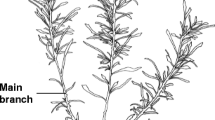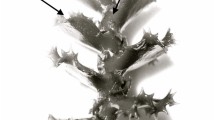Abstract
Life-history characteristics of two north Swedish populations of Stratiotes aloides L. are compared. On population consists of an emergent phenotype, living in a nutrient-rich lake. The other population is entirely formed by submersed plants, living in a nutrient-poor, riverside lagoon. Plants from each population transplanted to the other habitat showed that the emergent form was able to develop a submersed habit, whereas no significant change was observed in the submerged form.
The life cycle of the species is characterized by a winter-green period, during which the emergent form retained 36% and the submerged form 63% of its maximum biomass, respectively. Leaf turnover of both forms followed the same pattern, with successively increasing losses of old leaves during the growing season, resulting in an overwintering rosette made up of freshly-produced leaves. The number of turions and offsets produced by the emergent form is somewhat higher than those of the submerged form but the latter is suggested to allocate a greater proportion of energy to forming well-developed offsets. Under in situ experimental conditions during the growing season, the number of plants in both populations increased by 70% and no mortality was observed.
Concentration of potassium in the plant tissues of both forms increased throughout the growing season, that of calcium increased up to the time of peak biomass in August. The contents of phosphorus of the emergent plants transplanted to the lagoon decreased and the nitrogen content increased in relation to the mineral contents of the emergent plants in the lake. The opposite pattern in the contents of phosphorus and nitrogen was found for the submerged plants transplanted.
Similar content being viewed by others
References
Abrahamson, W. G., 1980. Demography and vegetative reproduction. Bot. Monogr. 15: 89–106.
Brammer, E. S., 1979. The littoral role of the water Soldier (Stratiotes aloides L.). Acta Univ. Ups. 540: 1–22.
Brammer, E. S. & R. G. Wetzel, 1984. Uptake and release of K+, Na+, and Ca2+ by the water soldier, Stratiotes aloides L. Aquat. Bot. 19: 119–130.
Cook, C. D. K. & K. Urmi-König, 1983. A revision of the genus Stratiotes (Hydrocharitaceae). Aquat. Bot. 16: 213–249.
Cook, R. E., 1983. Clonal plant populations. Amer. Sci. 71: 244–253.
Das, R. R. & Gopal, B., 1969. Vegetative propagation in Spirodela polyrrhiza. Trop. Ecol. 10: 270–277.
de Heus-Kruyt, M. & S. Segal, 1973. Notes on the productivity of Stratiotes aloides in two lakes in the Netherlands. Pol. Arch. Hydrobiol. 20: 195–205.
Erixon, G., 1979a. Environment and aquatic vegetation of a riverside lagoon in northern Sweden. Aquat. Bot. 6: 95–109.
Erixon, G., 1979b. Population ecology of a Stratiotes aloides L. stand in a riverside lagoon in N. Sweden. Hydrobiologia 67: 215–221.
Hill, B. H., 1979. Uptake and release of nutrients by aquatic macrophytes. Aquat. Bot. 7: 87–93.
Hutchings, M. J. & I. K. Bradbury, 1986. Ecological perspectives on clonal perennial herbs. BioScience 36(3): 178–181.
Kornatowski, J., 1976. Dynamics of Stratiotes aloides L. development. Pol. Arch. Hydrobiol. 23: 365–376.
Kornatowski, J., 1979. Turions and offsets of Stratiotes aloides L. Acta hydrobiol. 21: 185–204.
Kornatowski, J., 1983/84. Morphological forms of the water soldier (Stratiotes aloides L.). Acta hydrobiol. 25/26: 145–156.
Kornatowski, J., 1985. Phenological and morphometrical differentiation of the water soldier (Stratiotes aloides L.). Acta hydrobiol. 27: 33–47.
Moeller, R. E., 1977. Seasonal changes in biomass, tissue chemistry, and net production of the evergreen hydrophyte, Lobelia dortmanna. Can. J. Bot. 56: 1425–1433.
Murphy, J. & J. P. Riley, 1962. A modified single-solution method for the determination of phosphate in natural waters. Anal. chim. Acta 27: 31–36.
Nolte, E., 1825. Botanische Bemerkungen über Stratiotes und Sagittaria. Kopenhagen.
Salzman, A. G., 1985. Habitat selection in a clonal plant. Science 228: 603–604.
Sculthorpe, C. D., 1967. The Biology of Aquatic Vascular Plants. Edward Arnold, London.
Tolonen, K., 1981. The history of the Stratiotes lakes of northern Fennoscandia in the light of stratigraphical studies. Wahlenbergia 7: 167–177.
Ulehlova, B., 1971. Decomposition and humification of plant material in the vegetation of Stratiotes aloides in NW Overijssel, Holland. Hydrobiologia 12: 279–286.
Wesenberg-Lund, C., 1912. Uber einige eigentümliche Temperaturverhältnisse in der Litoralregion der baltischen Seen und deren Bedeutung, nebst einem Anhang über die geographische Verbreitung der zwei Geschlechter von Stratiotes aloides. Internat. Revue der gesamten Hydrobiologie und Hydrographie 5(2–3): 287–316.
Author information
Authors and Affiliations
Rights and permissions
About this article
Cite this article
Renman, G. Life histories of two clonal populations of Stratiotes aloides L.. Hydrobiologia 185, 211–222 (1989). https://doi.org/10.1007/BF00036609
Received:
Revised:
Accepted:
Issue Date:
DOI: https://doi.org/10.1007/BF00036609




